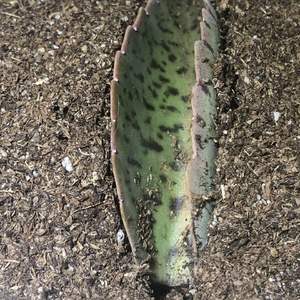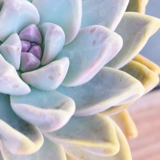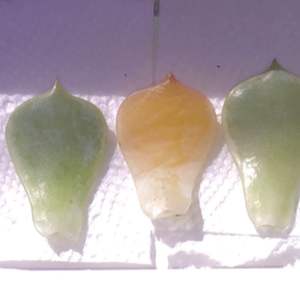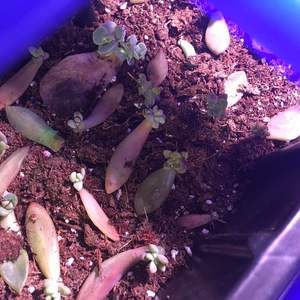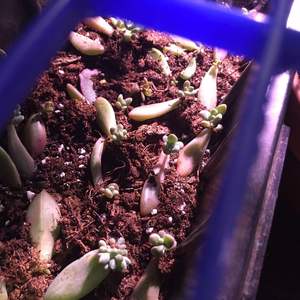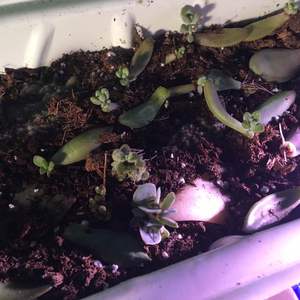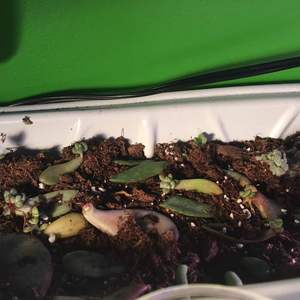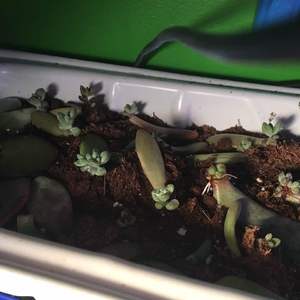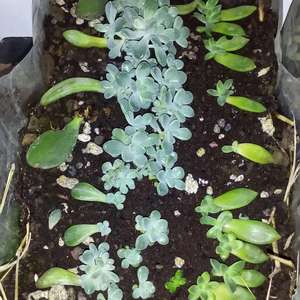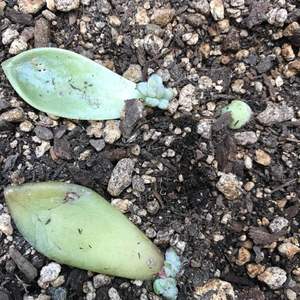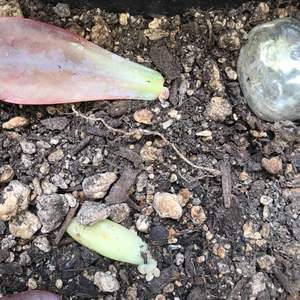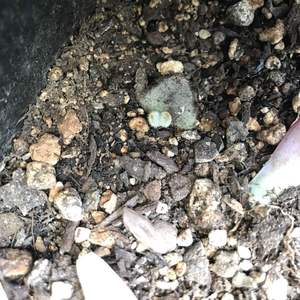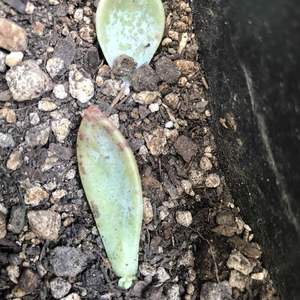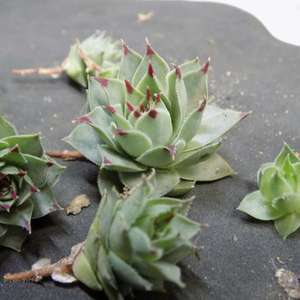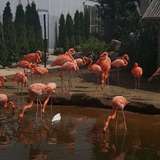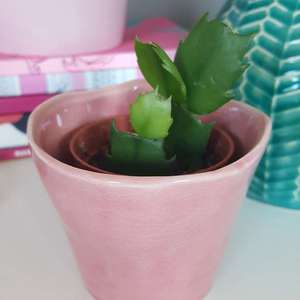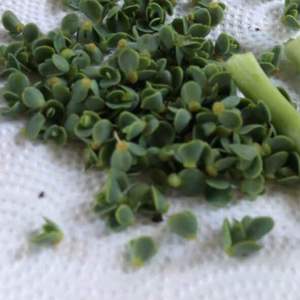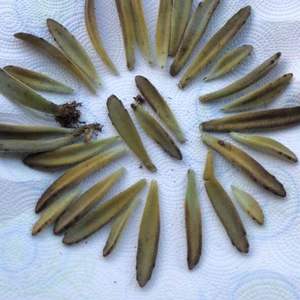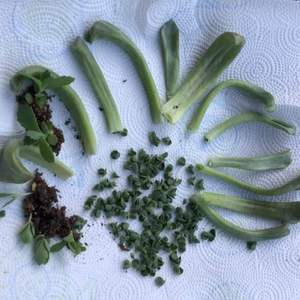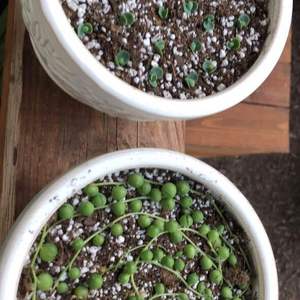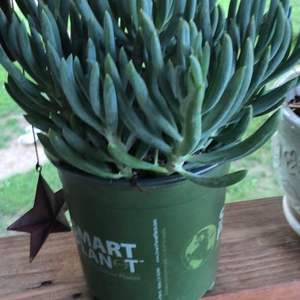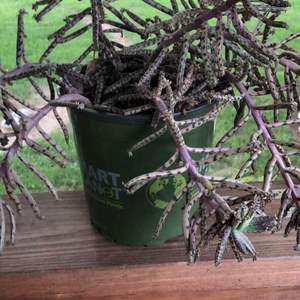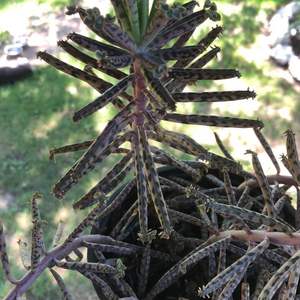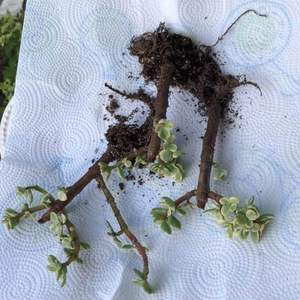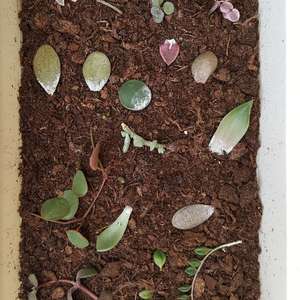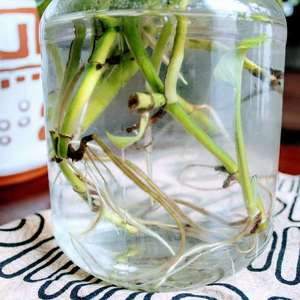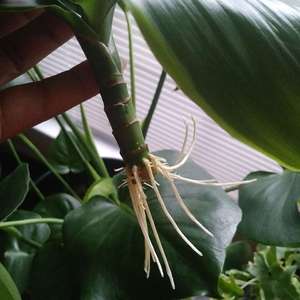文章
Miss Chen
2021年06月15日

Selecting the Cuttings
SELECT THE BEST POSSIBLE STOCK PLANTS
The best stock plants produce the best cuttings used for propagation. During each growing cycle, growers must select plants that exhibit the best growth characteristics; these are selected as ‘stock plants’. ‘Off-shore’ cuttings are from selected and maintained stock plants. The same selection process can be done at one’s own growing facility.
JUVENILE CUTTINGS
Cuttings taken from the newer juvenile parts of many plants root better than older mature parts. Shoots at the tops of the plant are physiologically older (more mature) than the shoots at the bottom of the plant (more juvenile). The top shoots have the characteristics of the more mature parts of the plant from which they originate. Juvenile cuttings require lower plant rooting hormone rates compared to the ‘older’ cuttings.
To maintain juvenality, annual and perennial cuttings should be taken from young stock plants. These stock plants, often a half year old, are used to produce the next generation stock plants from current cuttings. For woody plants ‘hedging’ can be done.
THE 'BEST' TIME TO TAKE CUTTINGS
Some plants, especially those which go dormant, have different rooting ability at different times of the year. Timing of a few weeks in taking of cuttings may have success or failure. After maturing to a certain age, often years, cuttings taken from certain plants may not be able to produce roots.
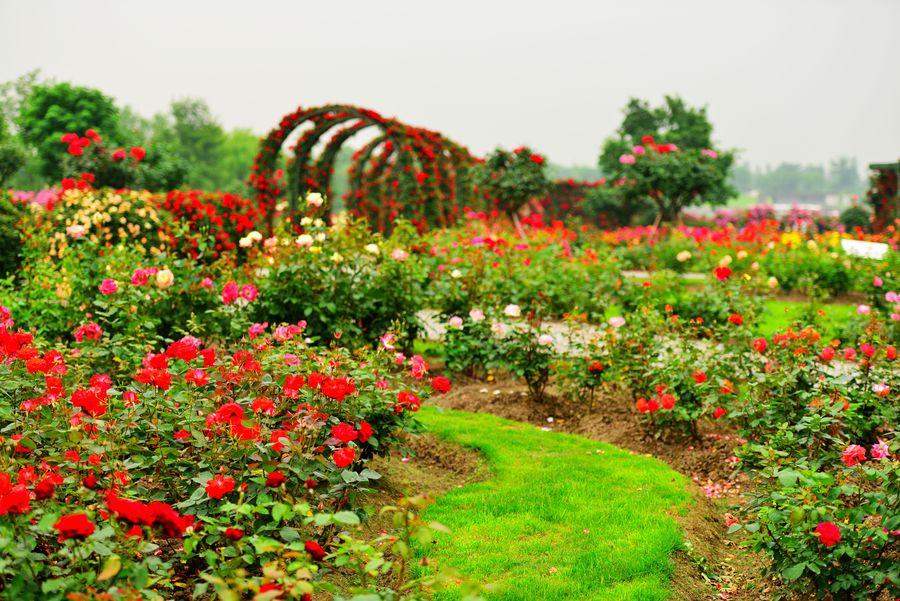
TYPICAL TIMING TO TAKE CUTTINGS
• Herbaceous cuttings from greenhouse crops, annual and tropical plants: anytime.
• Deciduous and evergreen plant cuttings: early summer through early fall.
• Dormant hardwood cuttings: fall or winter.
PREPARATION AND CARE OF CUTTINGS
Before taking cuttings, stock plants must be provided with good light and fertilization. This will boost stored carbohydrates used to feed the newly formed roots.
• Herbaceous plant cuttings should be treated and stuck soon after being taken. To prevent heat damage, in hot climates cuttings are put in coolers soon after being cut. Perennial and annual cutting suppliers may have offshore stock plant nurseries. When shipped, cuttings from these nurseries are kept chilled during transit using special cartons that protect the cuttings from temperature variation. The cuttings are packed in plastic bags to assure continued hydration. Shipping time is kept short, assuring prompt arrival at the rooting facility. Certain plants do not ship well; to assure propagation success, those stock plants should be grown near the rooting faculty.
• Winter woody cuttings taken in the fall can be treated with rooting hormones, kept in plastic, stored in cold storage, then planted-out in the spring.
• Growers usually take plant shoot cuttings from plant growth of the current growing season. Generally, thin cuttings will root more easily than thick cuttings. No one cutting type is useful to propagate all plants.
TYPES OF CUTTINGS
STEM CUTTINGS
‘Stem cuttings’ are the out-growing stems, mature sprouts or tip cuttings. Growers may take many types of stem cuttings.
• SOFTWOOD & HERBACEOUS CUTTINGS:
these are the fast growing soft tips of stems, usually taken in the spring. Herbaceous cuttings, sometimes called ‘tip cuttings’ or ‘shoot cuttings’, are taken from the young soft tips of stems.
Softwood and Herbaceous cuttings have many variations. Cuttings taken from annuals, herbaceous perennials, tropical plants and house plants are easier to propagate from cuttings than more hardened cuttings.
• HARDWOOD CUTTINGS:
these are taken from the fully mature stems of deciduous shrubs and trees. Stock plants for these cuttings require careful selection and preparation before growers take the cuttings. Pruning of the stock plants allow them to produce new growth early in the growing season. The new growth can produce roots. Growers take these cuttings at the end of the growing season or during the dormant season.
• GREENWOOD CUTTINGS:
these are the soft tips or stems after the spring growth has slowed. The stem is harder and woodier than the soft wood cutting.
• SEMI-RIPE CUTTINGS:
these are taken during the late summer after the annual growth has slowed. The stem is harder than softwood or green wood cuttings.
Other Types of Cuttings
SCION CUTTINGS
‘Scion cuttings’ are dormant 'ligneous' woody twigs.
EYE CUTTINGS
‘Eye cuttings’ are pieces of foliated or defoliated stalks with one or more eyes.
ROOT CUTTINGS
‘Root cuttings’ are parts of the root, usually annual. Growers take these from certain plants which have the capacity to regenerate stems from root parts.
LEAF CUTTINGS
‘Leaf cuttings’ are parts of the leaf. New roots develop at the base or veins of the cutting. Dry powder rooting hormones are usually used to treat these cuttings.
HANDLING UN-ROOTED CUTTIGS
• After taking cuttings, stick as soon as possible.
• USE PLANT ROOTING HORMONES.
• Do inspection.
• Reduce wilting during rooting.
• Maintain the appropriate environmental controls.
• Practice good sanitation.
HANDLING OFF-SHORE UN-ROOTED CUTTINGS
After receiving cuttings from off-shore sources, open all boxes immediately. Inspect the un-rooted cuttings for damage, dehydration, heat or freeze damage, breakage or rot. Report any missing items or damaged cuttings to the vendor. Do not allow the boxes to remain in sunny or hot places, or below freezing temperatures. Growers should stick the un-rooted cuttings into pre-moistened, well drained, soil-less media with 5.5- 6.5 pH. If it not possible to stick the un-rooted cuttings immediately they can be held for several days in a cooler between 35-45°F. The cuttings will deteriorate rapidly at warm temperatures.
WOUNDING
• Hardwood cuttings may root better if a 1/2 to 3/4 inch long notch, “wound,” is made at the basal end before applying the plant rooting hormone.
• Tropical and other herbaceous cuttings are not 'wounded'.
MEDIA
Stick cuttings as soon as possible after either taking cuttings or receiving off-shore cuttings. Use pre-moistened, well drained, soil-less media with 5.5- 6.5 pH. ‘Airy’ media allows oxygen to stimulate root growth. (See page 45 for notes.)

STICKING DEPTH
Stick the cuttings just deep enough that the medium anchors them. Thin cutting may be stuck 1/4-1/2 inch deep.
TRAY SIZE AND DIRECT STICKING
Tray sizes range from 36 to 128 cell. Larger cells are used for cuttings scheduled to remain in the starting tray longer. Un-rooted cuttings can also direct stick in the finishing container or sometimes beds.
ROOTING SOLUTIONS AND ROOTING POWDERS
Hortus IBA Water Soluble Salts & Rhizopon AA dry powder rooting hormones are applied to cuttings from ‘easy-to-root’ to ‘difficult-to-root’. Treated cuttings quickly form new uniform roots, strong root mass and homogenous propagation crops.
CONTROL OF THE GROWING AREA
Raising selected stock plants under controlled conditions is important. When growers give their stock plants proper care, the plants will produce the best cuttings. ‘Just taking’ cuttings from random ‘field plants’ leads to marginal results. The same way, control of the propagation house is equally important to the propagation of new plants.
Before production, always perform trials on selected plants, within the same facility.
INSPECTION
Growers must inspect their crops regularly to observe both intended and undesired results. Records should be kept that include information of the methods, materials, and plants used, and the quality of stock plants and cuttings.
ROOTED CUTTING CARE
Early stage treatment of the cutting crop is essential to produce high quality finished plants. Do not allow the rooted cuttings to become over-rooted, dried-out, crowded or under-fertilized. These situations may reduce plant growth.
PROVIDING THE BEST POSSIBLE CONDITIONS FOR ROOTING
Cuttings given less than optimal rooting conditions will waste energy. The result will be inferior root systems. To produce its own store of carbohydrates a plant needs the raw materials of light, water, carbon dioxide and oxygen.
LIGHT
Growers should regulate the propagation house so that the cuttings are not under direct sunlight. The effect of direct sunlight and the resultant heat will cause stress to the cuttings. Light is necessary for photosynthesis. Un-rooted cuttings are not able to engage in much photosynthesis; a small amount of light, 100-125 um PAR light, during the rooting process is sufficient. It is important at this stage is to provide a long period of light. A photo-period of 16-18 hours is adequate. Artificial lights are useful to extend natural daylight hours. Natural lighting or artificial lights may cause a rise in ambient temperature. Growers must control the growing area to avoid high temperatures from light sources.
WATER CONTENT OF THE MEDIA
A plant must have a good root system in order for it to absorb water. Water is crucial while the cuttings begin to form roots. If the substrate that is too dry, the plant will have cell death. Dead cells increase the risk of rot. A very dry substrate encourages callus formation. Although many believe that callus is beneficial for root formation, this is not true. The callus hinders and slows root formation. Growers measure how much moisture in the soil with a tensiometer. For best rooting, the meter should display a reading between moist and wet. Another way is to weigh the trays regularly. By trial, the growers determine if the trays have the proper weight for the “the proper moisture level,” then provide water based on these observations.
CARBON DIOXIDE (CO2) IN AIR & OXYGEN IN MEDIA
Photosynthesis is important for cuttings. Photosynthesis requires sufficient carbon dioxide (CO2), light, and water. An advantage of an increased level of CO2 in the air is that it reduces the transpiration, loss of water, through the plant. Cuttings in an environment with sufficient light and an increased CO2 level (800-1000 ppm) will form better roots. CO2 can be controlled using special generators. Oxygen is necessary for cell division and crucial for root formation. Growers must stick the cuttings into a substrate that has a structure which is sufficiently open to allow air, containing oxygen, to reach the developing roots. Dense media inhibits oxygen stimulation.
AIR CIRCULATION & TEMPERATURE CONTROL
Good air circulation is necessary when rooting un-rooted cuttings. Shade to approximately 50% light conditions, or as required, to reduce temperature during high heat periods.
TEMPERATURE
• Soil Temperature
Soil temperature has a direct influence on the speed of rooting. A soil temperature ranging between 68-77°F is ideal during the initial rooting stage. After this initial stage, growers can allow the temperature to drop a few degrees.
• Air Temperature
To prevent excess transpiration, controlling the temperature is important. To reduce aerial growth, air temperature should be a bit lower than soil temperature. The cuttings should be encouraged to use their energy mainly for developing roots. Above ground growth will come later.
• Light and Temperature Relationship
During the winter, when there is a low level of natural light, with no artificial lights, use a lower temperature. For example, cuttings will die if kept at temperatures near 74°F, short day and low light levels. Rooting activity in the soil will outpace its ability to do photosynthesis induced by the light.
FERTILIZATION
Follow fertilizer label instructions. Growers should fertilize un-rooted cuttings during propagation. Apply a complete N-P-K fertilizer. For many plants, use a fertilizer containing 300 ppm of nitrogen approximately two to three times a week. Start on the third day after sticking or when the callus is starting to form. Quality can suffer if the roots become rootbound. Fertilize the cuttings when planting. Apply liquid fertilizer solutions at a rate of 300 to 400 ppm immediately after planting.
INSECT AND DISEASE CONTROL
Good cultural practices and clean, well-ventilated growing space are your best defense against disease. Botrytis, the chief fungal threat, thrives in a moist, stagnant environment. Good air circulation and adequate light will reduce its harmful effects. Apply appropriate fungicides, insecticides, and other control products following label instructions.
HUMIDITY
Un-rooted cuttings must receive the highest amount of humidity. Temperature influences the ambient humidity. When the first roots appear, the humidity can be lowered; the rooted cuttings can adapt to the surroundings better.
MISTING GUIDELINES
Apply mist immediately and frequently to maintain turgidity and minimize wilting while roots develop. Extended days of high humidity may cause some plant cuttings to form aerial roots.
SELECT THE BEST POSSIBLE STOCK PLANTS
The best stock plants produce the best cuttings used for propagation. During each growing cycle, growers must select plants that exhibit the best growth characteristics; these are selected as ‘stock plants’. ‘Off-shore’ cuttings are from selected and maintained stock plants. The same selection process can be done at one’s own growing facility.
JUVENILE CUTTINGS
Cuttings taken from the newer juvenile parts of many plants root better than older mature parts. Shoots at the tops of the plant are physiologically older (more mature) than the shoots at the bottom of the plant (more juvenile). The top shoots have the characteristics of the more mature parts of the plant from which they originate. Juvenile cuttings require lower plant rooting hormone rates compared to the ‘older’ cuttings.
To maintain juvenality, annual and perennial cuttings should be taken from young stock plants. These stock plants, often a half year old, are used to produce the next generation stock plants from current cuttings. For woody plants ‘hedging’ can be done.
THE 'BEST' TIME TO TAKE CUTTINGS
Some plants, especially those which go dormant, have different rooting ability at different times of the year. Timing of a few weeks in taking of cuttings may have success or failure. After maturing to a certain age, often years, cuttings taken from certain plants may not be able to produce roots.

TYPICAL TIMING TO TAKE CUTTINGS
• Herbaceous cuttings from greenhouse crops, annual and tropical plants: anytime.
• Deciduous and evergreen plant cuttings: early summer through early fall.
• Dormant hardwood cuttings: fall or winter.
PREPARATION AND CARE OF CUTTINGS
Before taking cuttings, stock plants must be provided with good light and fertilization. This will boost stored carbohydrates used to feed the newly formed roots.
• Herbaceous plant cuttings should be treated and stuck soon after being taken. To prevent heat damage, in hot climates cuttings are put in coolers soon after being cut. Perennial and annual cutting suppliers may have offshore stock plant nurseries. When shipped, cuttings from these nurseries are kept chilled during transit using special cartons that protect the cuttings from temperature variation. The cuttings are packed in plastic bags to assure continued hydration. Shipping time is kept short, assuring prompt arrival at the rooting facility. Certain plants do not ship well; to assure propagation success, those stock plants should be grown near the rooting faculty.
• Winter woody cuttings taken in the fall can be treated with rooting hormones, kept in plastic, stored in cold storage, then planted-out in the spring.
• Growers usually take plant shoot cuttings from plant growth of the current growing season. Generally, thin cuttings will root more easily than thick cuttings. No one cutting type is useful to propagate all plants.
TYPES OF CUTTINGS
STEM CUTTINGS
‘Stem cuttings’ are the out-growing stems, mature sprouts or tip cuttings. Growers may take many types of stem cuttings.
• SOFTWOOD & HERBACEOUS CUTTINGS:
these are the fast growing soft tips of stems, usually taken in the spring. Herbaceous cuttings, sometimes called ‘tip cuttings’ or ‘shoot cuttings’, are taken from the young soft tips of stems.
Softwood and Herbaceous cuttings have many variations. Cuttings taken from annuals, herbaceous perennials, tropical plants and house plants are easier to propagate from cuttings than more hardened cuttings.
• HARDWOOD CUTTINGS:
these are taken from the fully mature stems of deciduous shrubs and trees. Stock plants for these cuttings require careful selection and preparation before growers take the cuttings. Pruning of the stock plants allow them to produce new growth early in the growing season. The new growth can produce roots. Growers take these cuttings at the end of the growing season or during the dormant season.
• GREENWOOD CUTTINGS:
these are the soft tips or stems after the spring growth has slowed. The stem is harder and woodier than the soft wood cutting.
• SEMI-RIPE CUTTINGS:
these are taken during the late summer after the annual growth has slowed. The stem is harder than softwood or green wood cuttings.
Other Types of Cuttings
SCION CUTTINGS
‘Scion cuttings’ are dormant 'ligneous' woody twigs.
EYE CUTTINGS
‘Eye cuttings’ are pieces of foliated or defoliated stalks with one or more eyes.
ROOT CUTTINGS
‘Root cuttings’ are parts of the root, usually annual. Growers take these from certain plants which have the capacity to regenerate stems from root parts.
LEAF CUTTINGS
‘Leaf cuttings’ are parts of the leaf. New roots develop at the base or veins of the cutting. Dry powder rooting hormones are usually used to treat these cuttings.
HANDLING UN-ROOTED CUTTIGS
• After taking cuttings, stick as soon as possible.
• USE PLANT ROOTING HORMONES.
• Do inspection.
• Reduce wilting during rooting.
• Maintain the appropriate environmental controls.
• Practice good sanitation.
HANDLING OFF-SHORE UN-ROOTED CUTTINGS
After receiving cuttings from off-shore sources, open all boxes immediately. Inspect the un-rooted cuttings for damage, dehydration, heat or freeze damage, breakage or rot. Report any missing items or damaged cuttings to the vendor. Do not allow the boxes to remain in sunny or hot places, or below freezing temperatures. Growers should stick the un-rooted cuttings into pre-moistened, well drained, soil-less media with 5.5- 6.5 pH. If it not possible to stick the un-rooted cuttings immediately they can be held for several days in a cooler between 35-45°F. The cuttings will deteriorate rapidly at warm temperatures.
WOUNDING
• Hardwood cuttings may root better if a 1/2 to 3/4 inch long notch, “wound,” is made at the basal end before applying the plant rooting hormone.
• Tropical and other herbaceous cuttings are not 'wounded'.
MEDIA
Stick cuttings as soon as possible after either taking cuttings or receiving off-shore cuttings. Use pre-moistened, well drained, soil-less media with 5.5- 6.5 pH. ‘Airy’ media allows oxygen to stimulate root growth. (See page 45 for notes.)

STICKING DEPTH
Stick the cuttings just deep enough that the medium anchors them. Thin cutting may be stuck 1/4-1/2 inch deep.
TRAY SIZE AND DIRECT STICKING
Tray sizes range from 36 to 128 cell. Larger cells are used for cuttings scheduled to remain in the starting tray longer. Un-rooted cuttings can also direct stick in the finishing container or sometimes beds.
ROOTING SOLUTIONS AND ROOTING POWDERS
Hortus IBA Water Soluble Salts & Rhizopon AA dry powder rooting hormones are applied to cuttings from ‘easy-to-root’ to ‘difficult-to-root’. Treated cuttings quickly form new uniform roots, strong root mass and homogenous propagation crops.
CONTROL OF THE GROWING AREA
Raising selected stock plants under controlled conditions is important. When growers give their stock plants proper care, the plants will produce the best cuttings. ‘Just taking’ cuttings from random ‘field plants’ leads to marginal results. The same way, control of the propagation house is equally important to the propagation of new plants.
Before production, always perform trials on selected plants, within the same facility.
INSPECTION
Growers must inspect their crops regularly to observe both intended and undesired results. Records should be kept that include information of the methods, materials, and plants used, and the quality of stock plants and cuttings.
ROOTED CUTTING CARE
Early stage treatment of the cutting crop is essential to produce high quality finished plants. Do not allow the rooted cuttings to become over-rooted, dried-out, crowded or under-fertilized. These situations may reduce plant growth.
PROVIDING THE BEST POSSIBLE CONDITIONS FOR ROOTING
Cuttings given less than optimal rooting conditions will waste energy. The result will be inferior root systems. To produce its own store of carbohydrates a plant needs the raw materials of light, water, carbon dioxide and oxygen.
LIGHT
Growers should regulate the propagation house so that the cuttings are not under direct sunlight. The effect of direct sunlight and the resultant heat will cause stress to the cuttings. Light is necessary for photosynthesis. Un-rooted cuttings are not able to engage in much photosynthesis; a small amount of light, 100-125 um PAR light, during the rooting process is sufficient. It is important at this stage is to provide a long period of light. A photo-period of 16-18 hours is adequate. Artificial lights are useful to extend natural daylight hours. Natural lighting or artificial lights may cause a rise in ambient temperature. Growers must control the growing area to avoid high temperatures from light sources.
WATER CONTENT OF THE MEDIA
A plant must have a good root system in order for it to absorb water. Water is crucial while the cuttings begin to form roots. If the substrate that is too dry, the plant will have cell death. Dead cells increase the risk of rot. A very dry substrate encourages callus formation. Although many believe that callus is beneficial for root formation, this is not true. The callus hinders and slows root formation. Growers measure how much moisture in the soil with a tensiometer. For best rooting, the meter should display a reading between moist and wet. Another way is to weigh the trays regularly. By trial, the growers determine if the trays have the proper weight for the “the proper moisture level,” then provide water based on these observations.
CARBON DIOXIDE (CO2) IN AIR & OXYGEN IN MEDIA
Photosynthesis is important for cuttings. Photosynthesis requires sufficient carbon dioxide (CO2), light, and water. An advantage of an increased level of CO2 in the air is that it reduces the transpiration, loss of water, through the plant. Cuttings in an environment with sufficient light and an increased CO2 level (800-1000 ppm) will form better roots. CO2 can be controlled using special generators. Oxygen is necessary for cell division and crucial for root formation. Growers must stick the cuttings into a substrate that has a structure which is sufficiently open to allow air, containing oxygen, to reach the developing roots. Dense media inhibits oxygen stimulation.
AIR CIRCULATION & TEMPERATURE CONTROL
Good air circulation is necessary when rooting un-rooted cuttings. Shade to approximately 50% light conditions, or as required, to reduce temperature during high heat periods.
TEMPERATURE
• Soil Temperature
Soil temperature has a direct influence on the speed of rooting. A soil temperature ranging between 68-77°F is ideal during the initial rooting stage. After this initial stage, growers can allow the temperature to drop a few degrees.
• Air Temperature
To prevent excess transpiration, controlling the temperature is important. To reduce aerial growth, air temperature should be a bit lower than soil temperature. The cuttings should be encouraged to use their energy mainly for developing roots. Above ground growth will come later.
• Light and Temperature Relationship
During the winter, when there is a low level of natural light, with no artificial lights, use a lower temperature. For example, cuttings will die if kept at temperatures near 74°F, short day and low light levels. Rooting activity in the soil will outpace its ability to do photosynthesis induced by the light.
FERTILIZATION
Follow fertilizer label instructions. Growers should fertilize un-rooted cuttings during propagation. Apply a complete N-P-K fertilizer. For many plants, use a fertilizer containing 300 ppm of nitrogen approximately two to three times a week. Start on the third day after sticking or when the callus is starting to form. Quality can suffer if the roots become rootbound. Fertilize the cuttings when planting. Apply liquid fertilizer solutions at a rate of 300 to 400 ppm immediately after planting.
INSECT AND DISEASE CONTROL
Good cultural practices and clean, well-ventilated growing space are your best defense against disease. Botrytis, the chief fungal threat, thrives in a moist, stagnant environment. Good air circulation and adequate light will reduce its harmful effects. Apply appropriate fungicides, insecticides, and other control products following label instructions.
HUMIDITY
Un-rooted cuttings must receive the highest amount of humidity. Temperature influences the ambient humidity. When the first roots appear, the humidity can be lowered; the rooted cuttings can adapt to the surroundings better.
MISTING GUIDELINES
Apply mist immediately and frequently to maintain turgidity and minimize wilting while roots develop. Extended days of high humidity may cause some plant cuttings to form aerial roots.
0
0
文章
Miss Chen
2021年05月26日

Plants produce new individuals similar to themselves, which is called reproduction. This is a natural phenomenon that plants reproduce and continue species, and it is also one of the basic characteristics of plant life. There are five main propagation methods of flowers: sowing, cutting, rameting, grafting and layering.
1. Sowing and breeding
basic concept
The sowing process is as follows: sterilize the soil in the sun, irrigate it with water, sprinkle the seeds evenly on the soil layer, then choose to cover the soil or not cover the leaves according to the size of the seeds, keep the soil moist, but do not accumulate water, move the flowerpot to the place with scattered light in time after the seeds germinate, and apply some liquid fertilizer, so that the seedlings can be transplanted when they have 2 ~ 3 leaves.
matters need attention
1. The sowing time of flowers is regular. Generally, open-field annual flowers and woody flowers are sown from March to April in spring, and the daily average temperature is stable at 15℃; open-field biennial flowers are mostly sown from August to September in autumn. The sowing date of greenhouse flowers often depends on the required flowering period. There is no strict seasonal restriction, but it is generally necessary to avoid the coldest and hottest seasons.
2. Flower seeds should absorb enough water before germination, and then they can extend radicle and germinate slowly. In order to meet the temperature, moisture and oxygen conditions required for seed germination, it is best to put the seeds in gauze bags before sowing, soak them in warm water at 40℃ for 24 hours, then spread them out on wet gauze, keep the gauze moist, and then sow them after the radicle of the seeds breaks through the seed coat.
3. Flower seeds are divided into four grades: large, medium, small and fine particles. The grain size of large seeds is above 0.5 cm, medium seeds are 0.2 ~ 0.5 cm, small seeds are 0.1 ~ 0.2 cm, and micro seeds are below 0.1 cm. Whether it is large, medium or small seeds, the sowing depth should be 2 ~ 3 times of the seed diameter. Large seeds can be sown in holes, the depth of which is 23 times of the diameter of the seeds, and the soil is flat with the bed surface after sowing; Medium-sized and small-sized seeds are first removed from the bed surface and then covered with a thin layer of soil; fine-sized seeds do not need to be covered with soil.
2. Cutting propagation
basic concept
Cutting propagation means taking a part of vegetative organs of a plant, inserting it into loose and wet soil or fine sand, and using its regeneration ability, making it take root and take branches to become a new plant.
Cuttage propagation
matters need attention
1. As the mother plant of cutting, it is required to have excellent varieties, vigorous growth and no diseases and insect pests, and the growing and aging plants should not be selected as the mother plant of cutting. On the same plant, the cuttings should choose branches whose middle and upper parts are sunny and full, and it is better to have shorter internodes, full bud heads and thick branches and leaves. On the same branch, hardwood cutting should choose the middle and lower parts of branches, because the middle and lower parts store more nutrients, while the tip tissues are often not full.
2. Cutting should be carried out immediately after cutting the sowing strips. Cutting strips such as rose, hibiscus syriacus, and clover, which are cut in late autumn, can be cut well, tied into bundles, buried in flowerpots with wet sand, and placed in a place where the indoor temperature is kept at 0~5℃. Pay attention not to make the sand too dry in winter, and then wait for the early spring of the following year before cutting. Flowers such as Chinese rose can also be cut in plastic shed in winter. Cuttings of succulent plants such as cactus should be dried in a ventilated place for about a week after cutting, and then cut when the cut mouth is slightly dry, otherwise it is easy to rot. Cutting cuttings of Begonia fortunei, oleander, etc., can be soaked in clear water after cutting, and can be directly planted into pots after rooting. For Chinese rose, Milan, etc., dip the lower mouth of cuttings in the injection of vitamin B, and then take it out for a minute or two, so that the liquid medicine can be sucked into cuttings and then inserted into coarse sand. This treatment can promote rooting.
3. After cuttage, management should be strengthened to create good rooting conditions for cuttings. Generally, rooting of flower cuttings requires both soil moisture and air circulation. Cover the cutting pots or beds with a cover made of glass plate or plastic film to keep the temperature and humidity. Small bricks should be placed under the hood to allow air to flow in. In summer and early autumn, the cuttage pots should be placed in shade during the day and in the open air at night; when the temperature is not enough in early, spring, late autumn and winter, they can be placed in warm places or greenhouses, but attention must be paid to the adjustment of temperature and humidity. In the future, according to the rooting speed of cuttings, gradually strengthen the illumination.
3. Branch propagation
basic concept
Ramet propagation is a method of dividing the sprouting branches, clumping branches, sucking buds and creeping branches of flowers from their mother plants and planting them as independent new plants, which is generally applicable to perennial flowers. The ramet method can be divided into two types: full division method and half division method.
division propagation
Full division method: dig out all the roots of the mother plants from the soil, and divide them into several small clusters by hand or scissors. Each small cluster can carry 1 ~ 3 branches, with roots at the lower part, and transplant them to other places or flowerpots respectively. After 3 ~ 4 years, it can be divided again.
Half-division method: when dividing plants, it is not necessary to dig out all the mother plants, but only dig out the soil around, on both sides or on one side of the mother plants to expose the root system, cut them into small clusters with l3 branches with roots at the lower part, and transplant these small clusters to other places to grow into new plants.
matters need attention
1. ramets have a high survival rate because they have complete roots, stems and leaves, but the number of reproduction is limited. This method is commonly used in strong species in tillering ability, such as Chimonanthus praecox, brown bamboo, phoenix-tailed bamboo, peony, peony, orchid, evergreen, Hosta Hosta, etc. In addition, small plants such as chlorophytum and Saxifraga stolonifera, and sucking buds (twigs) produced at the base of Sedum alfredii and Clematis chinensis in pulpy plants can be isolated and planted at any time.
2. Generally, flowers that bloom in early spring should be divided after stopping growing in autumn, and flowers that bloom in summer and autumn should be divided before sprouting in early spring.
4. Grafting and propagation
basic concept
Grafting is to use a part of the vegetative organs of plants to graft on other plants. Branches used for grafting are called scions, buds used are called grafted buds, grafted plants are called rootstocks, and grafted seedlings are called grafted seedlings. Grafting propagation is a good seed method for propagating clones, which is often used in plum blossom and rose. The principle of grafting survival is that the cambium of two plants with affinity heals at the junction, which makes the catheter and sieve tube communicate with each other to form a new individual.
Matters needing attention in grafting propagation
1. Grafting includes several methods, such as branch grafting, bud grafting, butt grafting (peeling off part of cortex of two plants with roots in bananas which are easy to approach in blue phase, and then joining with each other), pith grafting (scion and rootstock heal through pith), root grafting (using root as anvil), etc. However, no matter which method, attention should be paid to the management of temperature, light and water after grafting.
2. It is best to choose different plants which belong to the same genus or the same species as scions for rootstocks, because they have strong affinity, fast graft healing and high survival rate.
3. Rootstocks should have developed roots and strong growth, adapt to the local soil and climate, and have good resistance to pests.
4. Branches with full growth and full buds should be selected for scions.
5. The grafting season varies with different varieties of flowers and trees. For example, bud grafting for clove is mostly carried out in summer, and branch grafting for fuso can be carried out in spring and summer.
5, layering propagation
basic concept
Sliced propagation is a propagation method in which the branches attached to the mother plant form adventitious roots, and then cut off the mother plant to become a new individual. The layering propagation is mostly used for woody flowers which are easy to take root naturally in stems and internodes, but not easy to take root by cutting. The layering time can be carried out all the year round in warm areas, while it is mostly carried out in spring in the north. When layering propagation layering, in order to interrupt the downward transmission of organic substances (such as sugar, auxin and other substances) from the upper ends of leaves and branches, and make these substances accumulate on the upper parts of branches for use when rooting, ring peeling can be carried out. Applying IBA auxin to girdling site can promote rooting.
There are three layering methods: ordinary layering method, soil piling layering method and high branch layering method.
1. The common layering method is mostly used for vine flowers with soft and slender branches, such as Yingchun, Honeysuckle and Lingxiao. When layering, the periphery of the mother plant is bent into an arc shape, the bent protruding part is cut and buried in the soil, and then the bent part is fixed with hooks, and the mother plant can be cut off after it takes root, and then transplanted.
2. The method of stacking soil and layering is suitable for deciduous shrubs with strong tufts and hard branches that are not easy to bend, such as Redwood, Ulmus pumila and Rosa roxburghii. In early summer, the lower part of its branches is peeled for about 1 cm at a distance of about 25 cm from the soil, and then it is cultivated around the mother plant, and the lower part of the whole plant cluster is buried in the soil, and the soil pile is kept moist. After rooting and before sprouting in the next spring, dig the mound, cut the branches from the base to separate the mother plants, and then transplant them separately.
3. High-branch layering method is mostly used for evergreen flowers and trees, such as white orchid, Milan, smiling, etc. Generally, the layering of high branches is carried out in the peak growth season. The well-developed biennial branches are selected and peeled annularly at their proper positions. Then peat soil, mountain mud, moss, etc. are packed in plastic bags, which are used to wrap the branches, pour water through them, and fasten and fix the bags tightly. In the future, pay attention to timely water supply to keep the culture soil moist. After the branches take root, cut off the mother body from the bottom of the bag, remove the wrapped plastic bag, plant it in a pot with soil, and keep it in a cool place. After a large number of new shoots germinate, see you again.
The most obvious advantage of layering propagation is that it is easy to survive and can keep the characteristics of original varieties. This method can be used for some varieties that are difficult to reproduce by other propagation methods.
1. Sowing and breeding
basic concept
The sowing process is as follows: sterilize the soil in the sun, irrigate it with water, sprinkle the seeds evenly on the soil layer, then choose to cover the soil or not cover the leaves according to the size of the seeds, keep the soil moist, but do not accumulate water, move the flowerpot to the place with scattered light in time after the seeds germinate, and apply some liquid fertilizer, so that the seedlings can be transplanted when they have 2 ~ 3 leaves.
matters need attention
1. The sowing time of flowers is regular. Generally, open-field annual flowers and woody flowers are sown from March to April in spring, and the daily average temperature is stable at 15℃; open-field biennial flowers are mostly sown from August to September in autumn. The sowing date of greenhouse flowers often depends on the required flowering period. There is no strict seasonal restriction, but it is generally necessary to avoid the coldest and hottest seasons.
2. Flower seeds should absorb enough water before germination, and then they can extend radicle and germinate slowly. In order to meet the temperature, moisture and oxygen conditions required for seed germination, it is best to put the seeds in gauze bags before sowing, soak them in warm water at 40℃ for 24 hours, then spread them out on wet gauze, keep the gauze moist, and then sow them after the radicle of the seeds breaks through the seed coat.
3. Flower seeds are divided into four grades: large, medium, small and fine particles. The grain size of large seeds is above 0.5 cm, medium seeds are 0.2 ~ 0.5 cm, small seeds are 0.1 ~ 0.2 cm, and micro seeds are below 0.1 cm. Whether it is large, medium or small seeds, the sowing depth should be 2 ~ 3 times of the seed diameter. Large seeds can be sown in holes, the depth of which is 23 times of the diameter of the seeds, and the soil is flat with the bed surface after sowing; Medium-sized and small-sized seeds are first removed from the bed surface and then covered with a thin layer of soil; fine-sized seeds do not need to be covered with soil.
2. Cutting propagation
basic concept
Cutting propagation means taking a part of vegetative organs of a plant, inserting it into loose and wet soil or fine sand, and using its regeneration ability, making it take root and take branches to become a new plant.
Cuttage propagation
matters need attention
1. As the mother plant of cutting, it is required to have excellent varieties, vigorous growth and no diseases and insect pests, and the growing and aging plants should not be selected as the mother plant of cutting. On the same plant, the cuttings should choose branches whose middle and upper parts are sunny and full, and it is better to have shorter internodes, full bud heads and thick branches and leaves. On the same branch, hardwood cutting should choose the middle and lower parts of branches, because the middle and lower parts store more nutrients, while the tip tissues are often not full.
2. Cutting should be carried out immediately after cutting the sowing strips. Cutting strips such as rose, hibiscus syriacus, and clover, which are cut in late autumn, can be cut well, tied into bundles, buried in flowerpots with wet sand, and placed in a place where the indoor temperature is kept at 0~5℃. Pay attention not to make the sand too dry in winter, and then wait for the early spring of the following year before cutting. Flowers such as Chinese rose can also be cut in plastic shed in winter. Cuttings of succulent plants such as cactus should be dried in a ventilated place for about a week after cutting, and then cut when the cut mouth is slightly dry, otherwise it is easy to rot. Cutting cuttings of Begonia fortunei, oleander, etc., can be soaked in clear water after cutting, and can be directly planted into pots after rooting. For Chinese rose, Milan, etc., dip the lower mouth of cuttings in the injection of vitamin B, and then take it out for a minute or two, so that the liquid medicine can be sucked into cuttings and then inserted into coarse sand. This treatment can promote rooting.
3. After cuttage, management should be strengthened to create good rooting conditions for cuttings. Generally, rooting of flower cuttings requires both soil moisture and air circulation. Cover the cutting pots or beds with a cover made of glass plate or plastic film to keep the temperature and humidity. Small bricks should be placed under the hood to allow air to flow in. In summer and early autumn, the cuttage pots should be placed in shade during the day and in the open air at night; when the temperature is not enough in early, spring, late autumn and winter, they can be placed in warm places or greenhouses, but attention must be paid to the adjustment of temperature and humidity. In the future, according to the rooting speed of cuttings, gradually strengthen the illumination.
3. Branch propagation
basic concept
Ramet propagation is a method of dividing the sprouting branches, clumping branches, sucking buds and creeping branches of flowers from their mother plants and planting them as independent new plants, which is generally applicable to perennial flowers. The ramet method can be divided into two types: full division method and half division method.
division propagation
Full division method: dig out all the roots of the mother plants from the soil, and divide them into several small clusters by hand or scissors. Each small cluster can carry 1 ~ 3 branches, with roots at the lower part, and transplant them to other places or flowerpots respectively. After 3 ~ 4 years, it can be divided again.
Half-division method: when dividing plants, it is not necessary to dig out all the mother plants, but only dig out the soil around, on both sides or on one side of the mother plants to expose the root system, cut them into small clusters with l3 branches with roots at the lower part, and transplant these small clusters to other places to grow into new plants.
matters need attention
1. ramets have a high survival rate because they have complete roots, stems and leaves, but the number of reproduction is limited. This method is commonly used in strong species in tillering ability, such as Chimonanthus praecox, brown bamboo, phoenix-tailed bamboo, peony, peony, orchid, evergreen, Hosta Hosta, etc. In addition, small plants such as chlorophytum and Saxifraga stolonifera, and sucking buds (twigs) produced at the base of Sedum alfredii and Clematis chinensis in pulpy plants can be isolated and planted at any time.
2. Generally, flowers that bloom in early spring should be divided after stopping growing in autumn, and flowers that bloom in summer and autumn should be divided before sprouting in early spring.
4. Grafting and propagation
basic concept
Grafting is to use a part of the vegetative organs of plants to graft on other plants. Branches used for grafting are called scions, buds used are called grafted buds, grafted plants are called rootstocks, and grafted seedlings are called grafted seedlings. Grafting propagation is a good seed method for propagating clones, which is often used in plum blossom and rose. The principle of grafting survival is that the cambium of two plants with affinity heals at the junction, which makes the catheter and sieve tube communicate with each other to form a new individual.
Matters needing attention in grafting propagation
1. Grafting includes several methods, such as branch grafting, bud grafting, butt grafting (peeling off part of cortex of two plants with roots in bananas which are easy to approach in blue phase, and then joining with each other), pith grafting (scion and rootstock heal through pith), root grafting (using root as anvil), etc. However, no matter which method, attention should be paid to the management of temperature, light and water after grafting.
2. It is best to choose different plants which belong to the same genus or the same species as scions for rootstocks, because they have strong affinity, fast graft healing and high survival rate.
3. Rootstocks should have developed roots and strong growth, adapt to the local soil and climate, and have good resistance to pests.
4. Branches with full growth and full buds should be selected for scions.
5. The grafting season varies with different varieties of flowers and trees. For example, bud grafting for clove is mostly carried out in summer, and branch grafting for fuso can be carried out in spring and summer.
5, layering propagation
basic concept
Sliced propagation is a propagation method in which the branches attached to the mother plant form adventitious roots, and then cut off the mother plant to become a new individual. The layering propagation is mostly used for woody flowers which are easy to take root naturally in stems and internodes, but not easy to take root by cutting. The layering time can be carried out all the year round in warm areas, while it is mostly carried out in spring in the north. When layering propagation layering, in order to interrupt the downward transmission of organic substances (such as sugar, auxin and other substances) from the upper ends of leaves and branches, and make these substances accumulate on the upper parts of branches for use when rooting, ring peeling can be carried out. Applying IBA auxin to girdling site can promote rooting.
There are three layering methods: ordinary layering method, soil piling layering method and high branch layering method.
1. The common layering method is mostly used for vine flowers with soft and slender branches, such as Yingchun, Honeysuckle and Lingxiao. When layering, the periphery of the mother plant is bent into an arc shape, the bent protruding part is cut and buried in the soil, and then the bent part is fixed with hooks, and the mother plant can be cut off after it takes root, and then transplanted.
2. The method of stacking soil and layering is suitable for deciduous shrubs with strong tufts and hard branches that are not easy to bend, such as Redwood, Ulmus pumila and Rosa roxburghii. In early summer, the lower part of its branches is peeled for about 1 cm at a distance of about 25 cm from the soil, and then it is cultivated around the mother plant, and the lower part of the whole plant cluster is buried in the soil, and the soil pile is kept moist. After rooting and before sprouting in the next spring, dig the mound, cut the branches from the base to separate the mother plants, and then transplant them separately.
3. High-branch layering method is mostly used for evergreen flowers and trees, such as white orchid, Milan, smiling, etc. Generally, the layering of high branches is carried out in the peak growth season. The well-developed biennial branches are selected and peeled annularly at their proper positions. Then peat soil, mountain mud, moss, etc. are packed in plastic bags, which are used to wrap the branches, pour water through them, and fasten and fix the bags tightly. In the future, pay attention to timely water supply to keep the culture soil moist. After the branches take root, cut off the mother body from the bottom of the bag, remove the wrapped plastic bag, plant it in a pot with soil, and keep it in a cool place. After a large number of new shoots germinate, see you again.
The most obvious advantage of layering propagation is that it is easy to survive and can keep the characteristics of original varieties. This method can be used for some varieties that are difficult to reproduce by other propagation methods.
0
0
文章
Miss Chen
2018年08月07日

Bamboo plants are woody members of the grass family and consist of vertical, above-ground culms, and underground roots and rhizomes. A successful propagation must recreate all these parts. While reproduction from seed is the easiest way for the species to reproduce, bamboo plants do not produce many viable seeds. Consequently, bamboo is more commonly propagated by vegetative means. There are several types of vegetative propagation, and each have various advantages and drawbacks. Culm cutting, branch cutting, trench layering and marcotting propagation techniques essentially involve cutting a part off a bamboo in order to reroot it.
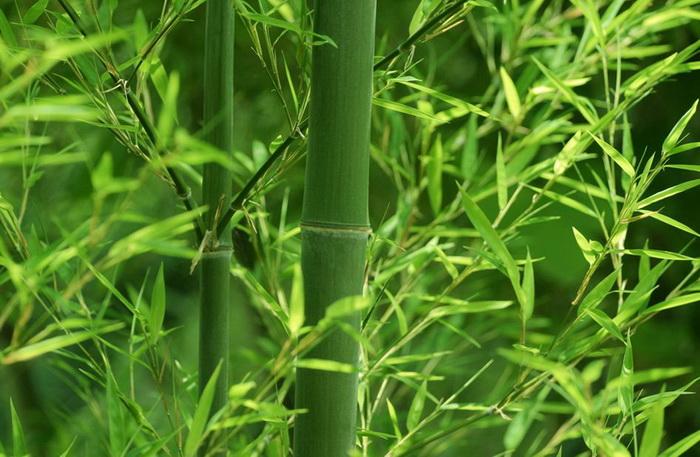
Culm Cutting
The culm cutting technique is used to successfully propagate most of the economically significant species of bamboo at a much faster rate than seed plantings. Begin by selecting only healthy culms 2 to 3 years in age. Cut the culm at ground level or slightly above the first node. Remove all leaves and small side branches. Use this culm to prepare several cuttings 2 to 3 nodes in length, leaving about 4 inches on each side. Place cuttings in a sandy, starting medium. Bury about 5 inches deep in dirt, totally covering up at least one node. New growth should appear in about 6 weeks.
Branch Cutting
Branch cutting propagation is a process that is very similar to culm cutting, but with branches. It works best with thick-walled bamboo cultivars. Select branches from 1- to 3-year-old culms. With both culm cutting and branch cuttings, rooting hormone applications will help produce better and faster results. Place branches in a growing medium upright or at a 20-degree angle. Special equipment like sand beds and mist chambers are often used to improve sprouting.
Trench Layering
Dig a long trench about 6 inches deep, long enough to accommodate a culm, lying horizontal, approximately 20 nodes long. Select a 2-year-old culm, stripping it of small branches and leaves. Cut through the culm, leaving about two thirds of its diameter. Place it in well-prepared soil, so that buds on the culm are in a lateral position. Shoots should start to appear at each node after about 3 months.

Marcotting
Marcotting is a bamboo propagation technique that is similar to trench layering. However, culms are not cut, but bent to a degree that will allow growers to physically reach plant nodes. In addition, propagation does not take place in the soil; instead it takes place in the air. A mixture of soil and rooting hormones are placed at each node. These materials are wrapped and physically bound to bamboo nodes using coconut fiber. Rooted nodes are later separated from the stem to become independent plants.

Culm Cutting
The culm cutting technique is used to successfully propagate most of the economically significant species of bamboo at a much faster rate than seed plantings. Begin by selecting only healthy culms 2 to 3 years in age. Cut the culm at ground level or slightly above the first node. Remove all leaves and small side branches. Use this culm to prepare several cuttings 2 to 3 nodes in length, leaving about 4 inches on each side. Place cuttings in a sandy, starting medium. Bury about 5 inches deep in dirt, totally covering up at least one node. New growth should appear in about 6 weeks.
Branch Cutting
Branch cutting propagation is a process that is very similar to culm cutting, but with branches. It works best with thick-walled bamboo cultivars. Select branches from 1- to 3-year-old culms. With both culm cutting and branch cuttings, rooting hormone applications will help produce better and faster results. Place branches in a growing medium upright or at a 20-degree angle. Special equipment like sand beds and mist chambers are often used to improve sprouting.
Trench Layering
Dig a long trench about 6 inches deep, long enough to accommodate a culm, lying horizontal, approximately 20 nodes long. Select a 2-year-old culm, stripping it of small branches and leaves. Cut through the culm, leaving about two thirds of its diameter. Place it in well-prepared soil, so that buds on the culm are in a lateral position. Shoots should start to appear at each node after about 3 months.

Marcotting
Marcotting is a bamboo propagation technique that is similar to trench layering. However, culms are not cut, but bent to a degree that will allow growers to physically reach plant nodes. In addition, propagation does not take place in the soil; instead it takes place in the air. A mixture of soil and rooting hormones are placed at each node. These materials are wrapped and physically bound to bamboo nodes using coconut fiber. Rooted nodes are later separated from the stem to become independent plants.
0
0
求助
tiffxnyvo
2018年07月28日

can anyone help me identify this mystery succulent? it’s super easy to accidentally remove the leaves, hence why i have so many in my propagation tray.
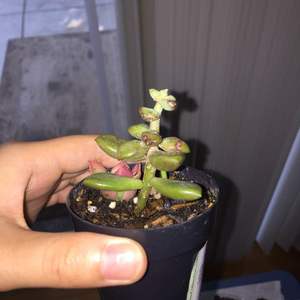
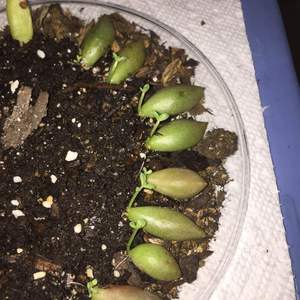


1
0
suculea:It streches because of lack of sunlight. it needs the biggest amount of direct sunlight that you can give it.
老毛:it may be a Sedum adolphii
and if you want to get your baby plant from the leaves,you should turn your leaves up side down




